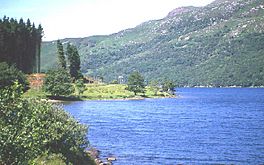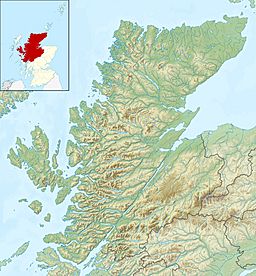Loch Arienas facts for kids
Quick facts for kids Loch Arienas |
|
|---|---|
 |
|
| Location | Morvern, Lochaber, Scotland |
| Coordinates | 55°35′44″N 5°46′36″W / 55.595500°N 5.776600°W |
| Type | freshwater |
| Primary inflows | Arienas Burn, Allt Àgh Choire |
| Primary outflows | Loch Doire nam Mart, River Aline |
| Basin countries | Scotland |
| Max. length | 3.2 km (2.0 mi) |
| Max. width | 1.21 km (0.75 mi) |
| Surface area | 170 ha (420 acres) |
| Average depth | 17.2 m (56 ft) |
| Max. depth | 35 m (115 ft) |
| Water volume | 29,300,000 m3 (1.03×109 cu ft) |
| Shore length1 | 8 km (5.0 mi) |
| Surface elevation | 12 m (39 ft) |
| 1 Shore length is not a well-defined measure. | |
Loch Arienas is a beautiful freshwater loch (that's a Scottish word for lake!) located in a part of Scotland called the Morvern peninsula. It's found within the large Ardtornish Estate in the Scottish Highlands. This loch is quite big, stretching about 3.2 km (2.0 mi) long and 1.21 km (0.75 mi) wide. It sits at a low elevation, only about 12 m (39 ft) above sea level.
Contents
Discovering Loch Arienas
Loch Arienas is a large, freshwater loch. It runs from the west-northwest to the east-southeast. The northern side of the loch has a fairly smooth shape. However, the southern side is more uneven, with lots of small inlets and bays.
How Deep is the Loch?
The average depth of Loch Arienas is about 17.2 m (56 ft). At its deepest point, the loch goes down to 35 m (115 ft). That's like stacking several school buses on top of each other!
Mapping the Loch
More than a hundred years ago, in August 1904, a man named John Hewitt carefully surveyed Loch Arienas. This survey was part of a bigger project led by Sir John Murray. He was creating a detailed map of all the freshwater lochs in Scotland. This project, called the Bathymetrical Survey of Fresh-Water Lochs of Scotland, took place between 1897 and 1909.
Life in the Loch
Loch Arienas is home to native wild brown trout. These fish are a popular catch for anglers. If you want to fish in the loch, you need to get special permission first. This helps protect the fish and their environment.
History Around the Shores
The areas around Loch Arienas hold clues to the past. In the woods on the northern shore, you can find the remains of old huts. These were used by charcoal burners. They would make charcoal here, which was an important fuel long ago. You can also see platforms where they worked.
There's also an old stone dyke (a wall made without mortar) near the loch. This wall was built around 1780. It might have been used to enclose the woods. This would have protected the trees from animals that grazed nearby, like sheep or cattle.


